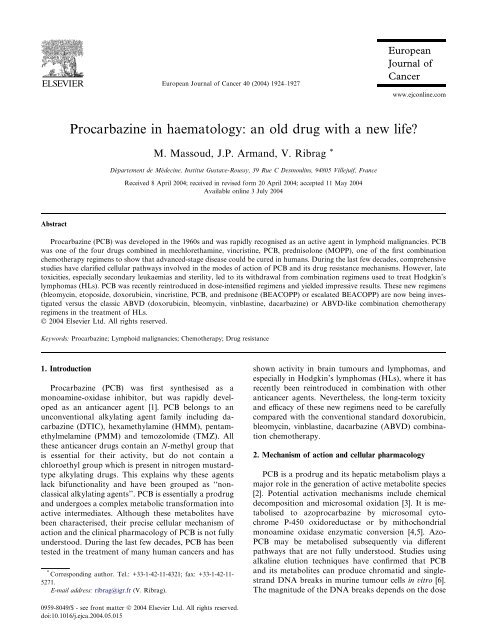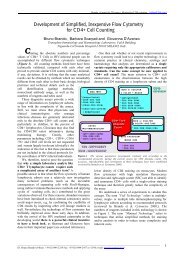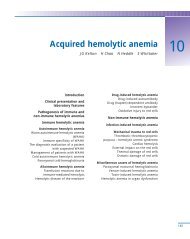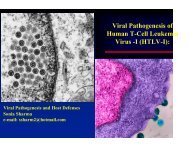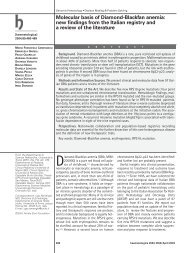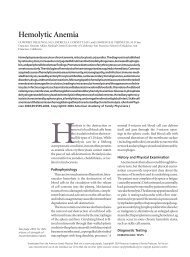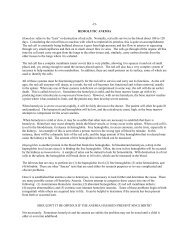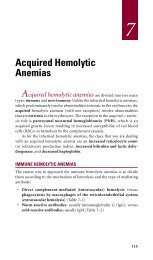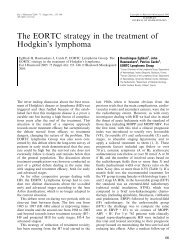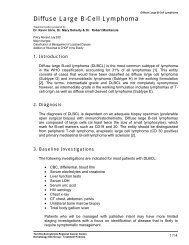Procarbazine in haematology: an old drug with a new life?
Procarbazine in haematology: an old drug with a new life?
Procarbazine in haematology: an old drug with a new life?
Create successful ePaper yourself
Turn your PDF publications into a flip-book with our unique Google optimized e-Paper software.
Europe<strong>an</strong> Journal of C<strong>an</strong>cer 40 (2004) 1924–1927<br />
Europe<strong>an</strong><br />
Journal of<br />
C<strong>an</strong>cer<br />
www.ejconl<strong>in</strong>e.com<br />
<strong>Procarbaz<strong>in</strong>e</strong> <strong>in</strong> <strong>haematology</strong>: <strong>an</strong> <strong>old</strong> <strong>drug</strong> <strong>with</strong> a <strong>new</strong> <strong>life</strong><br />
M. Massoud, J.P. Arm<strong>an</strong>d, V. Ribrag *<br />
Departement de Medec<strong>in</strong>e, Institut Gustave-Roussy, 39 Rue C Desmoul<strong>in</strong>s, 94805 Villejuif, Fr<strong>an</strong>ce<br />
Received 8 April 2004; received <strong>in</strong> revised form 20 April 2004; accepted 11 May 2004<br />
Available onl<strong>in</strong>e 3 July 2004<br />
Abstract<br />
<strong>Procarbaz<strong>in</strong>e</strong> (PCB) was developed <strong>in</strong> the 1960s <strong>an</strong>d was rapidly recognised as <strong>an</strong> active agent <strong>in</strong> lymphoid malign<strong>an</strong>cies. PCB<br />
was one of the four <strong>drug</strong>s comb<strong>in</strong>ed <strong>in</strong> mechloretham<strong>in</strong>e, v<strong>in</strong>crist<strong>in</strong>e, PCB, prednisolone (MOPP), one of the first comb<strong>in</strong>ation<br />
chemotherapy regimens to show that adv<strong>an</strong>ced-stage disease could be cured <strong>in</strong> hum<strong>an</strong>s. Dur<strong>in</strong>g the last few decades, comprehensive<br />
studies have clarified cellular pathways <strong>in</strong>volved <strong>in</strong> the modes of action of PCB <strong>an</strong>d its <strong>drug</strong> resist<strong>an</strong>ce mech<strong>an</strong>isms. However, late<br />
toxicities, especially secondary leukaemias <strong>an</strong>d sterility, led to its <strong>with</strong>drawal from comb<strong>in</strong>ation regimens used to treat Hodgk<strong>in</strong>’s<br />
lymphomas (HLs). PCB was recently re<strong>in</strong>troduced <strong>in</strong> dose-<strong>in</strong>tensified regimens <strong>an</strong>d yielded impressive results. These <strong>new</strong> regimens<br />
(bleomyc<strong>in</strong>, etoposide, doxorubic<strong>in</strong>, v<strong>in</strong>crist<strong>in</strong>e, PCB, <strong>an</strong>d prednisone (BEACOPP) or escalated BEACOPP) are now be<strong>in</strong>g <strong>in</strong>vestigated<br />
versus the classic ABVD (doxorubic<strong>in</strong>, bleomyc<strong>in</strong>, v<strong>in</strong>blast<strong>in</strong>e, dacarbaz<strong>in</strong>e) or ABVD-like comb<strong>in</strong>ation chemotherapy<br />
regimens <strong>in</strong> the treatment of HLs.<br />
Ó 2004 Elsevier Ltd. All rights reserved.<br />
Keywords: <strong>Procarbaz<strong>in</strong>e</strong>; Lymphoid malign<strong>an</strong>cies; Chemotherapy; Drug resist<strong>an</strong>ce<br />
1. Introduction<br />
<strong>Procarbaz<strong>in</strong>e</strong> (PCB) was first synthesised as a<br />
monoam<strong>in</strong>e-oxidase <strong>in</strong>hibitor, but was rapidly developed<br />
as <strong>an</strong> <strong>an</strong>tic<strong>an</strong>cer agent [1]. PCB belongs to <strong>an</strong><br />
unconventional alkylat<strong>in</strong>g agent family <strong>in</strong>clud<strong>in</strong>g dacarbaz<strong>in</strong>e<br />
(DTIC), hexamethylam<strong>in</strong>e (HMM), pentamethylmelam<strong>in</strong>e<br />
(PMM) <strong>an</strong>d temozolomide (TMZ). All<br />
these <strong>an</strong>tic<strong>an</strong>cer <strong>drug</strong>s conta<strong>in</strong> <strong>an</strong> N-methyl group that<br />
is essential for their activity, but do not conta<strong>in</strong> a<br />
chloroethyl group which is present <strong>in</strong> nitrogen mustardtype<br />
alkylat<strong>in</strong>g <strong>drug</strong>s. This expla<strong>in</strong>s why these agents<br />
lack bifunctionality <strong>an</strong>d have been grouped as ‘‘nonclassical<br />
alkylat<strong>in</strong>g agents’’. PCB is essentially a pro<strong>drug</strong><br />
<strong>an</strong>d undergoes a complex metabolic tr<strong>an</strong>sformation <strong>in</strong>to<br />
active <strong>in</strong>termediates. Although these metabolites have<br />
been characterised, their precise cellular mech<strong>an</strong>ism of<br />
action <strong>an</strong>d the cl<strong>in</strong>ical pharmacology of PCB is not fully<br />
understood. Dur<strong>in</strong>g the last few decades, PCB has been<br />
tested <strong>in</strong> the treatment of m<strong>an</strong>y hum<strong>an</strong> c<strong>an</strong>cers <strong>an</strong>d has<br />
* Correspond<strong>in</strong>g author. Tel.: +33-1-42-11-4321; fax: +33-1-42-11-<br />
5271.<br />
E-mail address: ribrag@igr.fr (V. Ribrag).<br />
shown activity <strong>in</strong> bra<strong>in</strong> tumours <strong>an</strong>d lymphomas, <strong>an</strong>d<br />
especially <strong>in</strong> Hodgk<strong>in</strong>’s lymphomas (HLs), where it has<br />
recently been re<strong>in</strong>troduced <strong>in</strong> comb<strong>in</strong>ation <strong>with</strong> other<br />
<strong>an</strong>tic<strong>an</strong>cer agents. Nevertheless, the long-term toxicity<br />
<strong>an</strong>d efficacy of these <strong>new</strong> regimens need to be carefully<br />
compared <strong>with</strong> the conventional st<strong>an</strong>dard doxorubic<strong>in</strong>,<br />
bleomyc<strong>in</strong>, v<strong>in</strong>blast<strong>in</strong>e, dacarbaz<strong>in</strong>e (ABVD) comb<strong>in</strong>ation<br />
chemotherapy.<br />
2. Mech<strong>an</strong>ism of action <strong>an</strong>d cellular pharmacology<br />
PCB is a pro<strong>drug</strong> <strong>an</strong>d its hepatic metabolism plays a<br />
major role <strong>in</strong> the generation of active metabolite species<br />
[2]. Potential activation mech<strong>an</strong>isms <strong>in</strong>clude chemical<br />
decomposition <strong>an</strong>d microsomal oxidation [3]. It is metabolised<br />
to azoprocarbaz<strong>in</strong>e by microsomal cytochrome<br />
P-450 oxidoreductase or by mithochondrial<br />
monoam<strong>in</strong>e oxidase enzymatic conversion [4,5]. Azo-<br />
PCB may be metabolised subsequently via different<br />
pathways that are not fully understood. Studies us<strong>in</strong>g<br />
alkal<strong>in</strong>e elution techniques have confirmed that PCB<br />
<strong>an</strong>d its metabolites c<strong>an</strong> produce chromatid <strong>an</strong>d s<strong>in</strong>glestr<strong>an</strong>d<br />
DNA breaks <strong>in</strong> mur<strong>in</strong>e tumour cells <strong>in</strong> vitro [6].<br />
The magnitude of the DNA breaks depends on the dose<br />
0959-8049/$ - see front matter Ó 2004 Elsevier Ltd. All rights reserved.<br />
doi:10.1016/j.ejca.2004.05.015
M. Massoud et al. / Europe<strong>an</strong> Journal of C<strong>an</strong>cer 40 (2004) 1924–1927 1925<br />
<strong>an</strong>d time elapsed after treatment, suggest<strong>in</strong>g that the<br />
breaks occur dur<strong>in</strong>g or soon after DNA synthesis [7].<br />
In addition to these effects on nuclear DNA, PCB c<strong>an</strong><br />
<strong>in</strong>hibit DNA, RNA <strong>an</strong>d prote<strong>in</strong> synthesis [6]. Inhibition<br />
of prote<strong>in</strong> synthesis is delayed <strong>an</strong>d c<strong>an</strong> only be a late<br />
effect due to the <strong>in</strong>hibition of nucleic acid synthesis.<br />
Recent data suggest that PCB cytotoxicity is ma<strong>in</strong>ly<br />
mediated by its methylat<strong>in</strong>g properties. Dur<strong>in</strong>g PCB<br />
treatment, the generation of large amounts of 6 O-<br />
methylgu<strong>an</strong><strong>in</strong>e (also known as a mutagenic <strong>an</strong>d carc<strong>in</strong>ogenic<br />
agent) could contribute to PCB cytotoxicity<br />
[8–10]. Delays <strong>in</strong> the growth of tumours lack<strong>in</strong>g AGT<br />
(the enzyme mediat<strong>in</strong>g 6 O-methylgu<strong>an</strong><strong>in</strong>e repair) were<br />
observed follow<strong>in</strong>g the adm<strong>in</strong>istration of PCB to thymic<br />
nude mice bear<strong>in</strong>g xenografts derived from hum<strong>an</strong> malign<strong>an</strong>t<br />
gliomas <strong>an</strong>d medulloblastomas, compared <strong>with</strong><br />
mice <strong>with</strong> normal AGT activity, emphasis<strong>in</strong>g the import<strong>an</strong>ce<br />
of this methylat<strong>in</strong>g pathway <strong>in</strong> PCB <strong>an</strong>tic<strong>an</strong>cer<br />
activity [11].<br />
3. Drug resist<strong>an</strong>ce <strong>an</strong>d cl<strong>in</strong>ical pharmacology<br />
Recently, mech<strong>an</strong>isms of resist<strong>an</strong>ce to PCB have also<br />
suggested that the methylat<strong>in</strong>g activity of PCB plays a<br />
key role <strong>in</strong> its cellular toxicity. Resist<strong>an</strong>ce to PCB c<strong>an</strong><br />
develop rapidly <strong>in</strong> tumour cells. The above-mentioned<br />
relationship between PCB <strong>an</strong>d AGT activities suggests<br />
that resist<strong>an</strong>ce to this agent could be secondary to AGTmediated<br />
repair of 6 O-methylgu<strong>an</strong><strong>in</strong>e activity <strong>an</strong>d this is<br />
similar to resist<strong>an</strong>ce to nitrosourea which is also mediated<br />
by this enzyme [12]. Other <strong>drug</strong>-resist<strong>an</strong>ce mech<strong>an</strong>isms,<br />
such as hMSH2 mismatch-repair deficiency, have<br />
recently been identified <strong>in</strong> PCB <strong>drug</strong>-resist<strong>an</strong>ce [13–15].<br />
The recent identification of these <strong>drug</strong>-resist<strong>an</strong>ce mech<strong>an</strong>isms<br />
could be <strong>in</strong>strumental <strong>in</strong> the development of <strong>new</strong><br />
therapeutic strategies <strong>with</strong> PCB. Modulation of AGT<br />
activity has already been <strong>in</strong>vestigated.<br />
The pharmacok<strong>in</strong>etics <strong>an</strong>d metabolism of PCB have<br />
been studied mostly <strong>in</strong> laboratory <strong>an</strong>imals, <strong>an</strong>d such<br />
<strong>in</strong>formation <strong>in</strong> hum<strong>an</strong>s is <strong>in</strong>complete. The rapid <strong>an</strong>d<br />
extensive enzymatic metabolism of PCB plays a role <strong>in</strong><br />
the complexity of its pharmacok<strong>in</strong>etic <strong>an</strong>d excretion<br />
characteristics. PCB hydrochloride is available <strong>in</strong> 50 mg<br />
capsules. In HLs, it is usually given at a daily dose of<br />
100 mg/m 2 for 7–14 days [16]. After oral adm<strong>in</strong>istration,<br />
the <strong>drug</strong> is rapidly <strong>an</strong>d completely absorbed from the<br />
gastro<strong>in</strong>test<strong>in</strong>al tract. The biodistribution of PCB is not<br />
well known, but there is rapid equilibration of PCB<br />
between plasma <strong>an</strong>d cerebrosp<strong>in</strong>al fluid <strong>in</strong> hum<strong>an</strong>s. PCB<br />
treatment is able to alter its own metabolism: the total<br />
<strong>an</strong>d relative plasma concentrations of PCB metabolites<br />
were ch<strong>an</strong>ged after the adm<strong>in</strong>istration of 14 daily oral<br />
doses. There is a signific<strong>an</strong>t <strong>in</strong>crease <strong>in</strong> the azoPCB<br />
concentration over time, suggest<strong>in</strong>g that prior exposure<br />
to PCB <strong>in</strong>duces the production of this metabolite or<br />
delays its clear<strong>an</strong>ce. The major ur<strong>in</strong>ary metabolite is the<br />
biologically <strong>in</strong>active N-isopropylterephtamilic acid (70%<br />
of the <strong>drug</strong> dur<strong>in</strong>g the first 24 h). There is m<strong>in</strong>imal faecal<br />
<strong>an</strong>d respiratory excretion of the <strong>drug</strong> (from 4% to 12%<br />
<strong>an</strong>d 20% to 30%, respectively).<br />
4. Toxicity <strong>an</strong>d <strong>drug</strong> <strong>in</strong>teractions<br />
Long-term PCB toxicities rema<strong>in</strong>ed a major problem<br />
<strong>an</strong>d were responsible for the <strong>with</strong>drawal of PCB from<br />
recent comb<strong>in</strong>ation chemotherapy regimens, for example,<br />
ABVD <strong>in</strong> HLs. However, given the high activity of<br />
PCB <strong>in</strong> this disease, it has recently been re<strong>in</strong>troduced <strong>in</strong><br />
<strong>new</strong> dose-<strong>in</strong>tensified regimens, but at lower doses th<strong>an</strong> <strong>in</strong><br />
the classic mechloretham<strong>in</strong>e, v<strong>in</strong>crist<strong>in</strong>e, PCB, prednisolone<br />
(MOPP) regimen. PCB has profound azoospermic,<br />
teratogenic, mutagenic <strong>an</strong>d carc<strong>in</strong>ogenic effects that<br />
c<strong>an</strong> limit its use <strong>in</strong> hum<strong>an</strong>s [17–20].<br />
Rare side-effects, usually observed when large cohorts<br />
of patients are treated <strong>with</strong> a <strong>drug</strong>, have also been reported<br />
<strong>in</strong> recent decades: haemolysis <strong>in</strong> <strong>in</strong>dividuals <strong>with</strong><br />
glucose 6-phosphate dehydrogenase deficiency; hypersensitivity<br />
reactions, <strong>in</strong>clud<strong>in</strong>g maculo-papular sk<strong>in</strong><br />
rash, eos<strong>in</strong>ophilia, pulmonary <strong>in</strong>filtrates, or, rarely,<br />
tr<strong>an</strong>sient hepatic dysfunction. PCB pulmonary toxicity<br />
necessitates discont<strong>in</strong>uation of the <strong>drug</strong> [21–23].<br />
M<strong>an</strong>y <strong>drug</strong>–<strong>drug</strong> or <strong>drug</strong>–food <strong>in</strong>teractions are observed<br />
<strong>with</strong> PCB because of its extensive hepatic microsomal<br />
metabolism <strong>an</strong>d its capacity to <strong>in</strong>hibit monoam<strong>in</strong>e<br />
oxidase. Patients tak<strong>in</strong>g barbiturates, phenothiaz<strong>in</strong>es,<br />
narcotics, <strong>an</strong>d hypnotics or sedatives may experience<br />
potentiated effects of these <strong>drug</strong>s dur<strong>in</strong>g PCB therapy.<br />
Other <strong>drug</strong>s such as cimetid<strong>in</strong>e or phenobarbital (pretreatment<br />
<strong>with</strong> phenobarbital results <strong>in</strong> <strong>in</strong>creased PCB<br />
clear<strong>an</strong>ce) c<strong>an</strong> affect PCB hepatic metabolism.<br />
The <strong>in</strong>hibition of monoam<strong>in</strong>e oxidase also predisposes<br />
patients to acute hypertensive reactions after<br />
concomit<strong>an</strong>t therapy <strong>with</strong> tricyclic <strong>an</strong>tidepress<strong>an</strong>ts <strong>an</strong>d<br />
sympathomimetic <strong>drug</strong>s, as well as after <strong>in</strong>gestion of<br />
tyram<strong>in</strong>e-rich beverages or foods, such as red w<strong>in</strong>e,<br />
b<strong>an</strong><strong>an</strong>as, ripe cheese <strong>an</strong>d yogurt. After <strong>in</strong>gestion of alcohol,<br />
disulfiram-like reactions (sweat<strong>in</strong>g, facial flush<strong>in</strong>g<br />
<strong>an</strong>d headache) may occur.<br />
5. PCB <strong>in</strong> Hodgk<strong>in</strong>’s lymphoma therapy<br />
The development of cytotoxic <strong>drug</strong>s <strong>in</strong> the early 1960s<br />
dramatically improved the survival of patients <strong>with</strong> adv<strong>an</strong>ced<br />
HL [24]. Nitrogen mustard, PCB, v<strong>in</strong>crist<strong>in</strong>e <strong>an</strong>d<br />
prednisolone were shown to be active <strong>in</strong> HL as s<strong>in</strong>gle<br />
agents (see Table 1), but few patients achieved a complete<br />
response [25]. These responses were not long-lived<br />
<strong>an</strong>d cure was not achieved. At the National C<strong>an</strong>cer Institute,<br />
DeVita <strong>an</strong>d co-workers [16] developed a 4-<strong>drug</strong><br />
chemotherapy regimen MOPP which was the first to
1926 M. Massoud et al. / Europe<strong>an</strong> Journal of C<strong>an</strong>cer 40 (2004) 1924–1927<br />
Table 1<br />
Efficacy of s<strong>in</strong>gle agent chemotherapy <strong>in</strong> Hodgk<strong>in</strong>’s lymphoma<br />
Drug<br />
Response rate<br />
(%)<br />
Mechloretham<strong>in</strong>e 63 16<br />
V<strong>in</strong>crist<strong>in</strong>e 64 36<br />
<strong>Procarbaz<strong>in</strong>e</strong> 69 38<br />
Complete response<br />
(%)<br />
demonstrate that HL could be cured <strong>with</strong> a comb<strong>in</strong>ation<br />
of <strong>an</strong>tic<strong>an</strong>cer agents. The complete remission (CR) rate<br />
atta<strong>in</strong>ed was 84%, <strong>with</strong> relapse-free <strong>an</strong>d overall survival<br />
reach<strong>in</strong>g 66% <strong>an</strong>d 48%, respectively, after more th<strong>an</strong> 20<br />
years. PCB certa<strong>in</strong>ly played a major role by produc<strong>in</strong>g a<br />
synergistic effect <strong>with</strong> other <strong>drug</strong>s. The St<strong>an</strong>ford group<br />
found that the dose <strong>an</strong>d dose rate of nitrogen mustard,<br />
v<strong>in</strong>crist<strong>in</strong>e <strong>an</strong>d procarbaz<strong>in</strong>e were crucial factors <strong>in</strong><br />
obta<strong>in</strong><strong>in</strong>g a complete remission [26]. MOPP rapidly<br />
became the ‘‘g<strong>old</strong> st<strong>an</strong>dard’’ therapy for patients <strong>with</strong><br />
adv<strong>an</strong>ced HL. Associated acute toxicities were common<br />
<strong>an</strong>d m<strong>an</strong>ageable, but <strong>in</strong>fertility <strong>an</strong>d secondary acute<br />
leukaemia (sAML) were serious long-term toxicities.<br />
The risk of develop<strong>in</strong>g sAML was ma<strong>in</strong>ly due to the<br />
association of PCB <strong>with</strong> mechloretham<strong>in</strong>e <strong>an</strong>d to the<br />
cumulative dose of these alkylat<strong>in</strong>g agents [27,28].<br />
sAML beg<strong>an</strong> 2 years follow<strong>in</strong>g therapy, <strong>an</strong>d decl<strong>in</strong>ed by<br />
11 years, <strong>with</strong> a peak-<strong>in</strong>cidence at 6 years. These sAML<br />
often presented <strong>with</strong> total or partial deletion of chromosomes<br />
5 <strong>an</strong>d 7 at cytogenetic <strong>an</strong>alysis, were poorly<br />
chemosensitive <strong>an</strong>d the prognosis was extremely dismal<br />
<strong>with</strong> a medi<strong>an</strong> survival of only 0.4 of a year [29,30].<br />
Infertility arose <strong>in</strong> more th<strong>an</strong> 90% of males after treatment<br />
<strong>with</strong> a PCB-based regimen like MOPP: azoospermia<br />
<strong>an</strong>d oligospermia were irreversible <strong>an</strong>d often<br />
occurred after treatment <strong>with</strong> more th<strong>an</strong> 3 cycles of<br />
MOPP. The rema<strong>in</strong><strong>in</strong>g 10% of male patients recovered<br />
spermatogenesis <strong>with</strong><strong>in</strong> 1–7 years follow<strong>in</strong>g the end of<br />
chemotherapy. 80–100% of women over the age of 25<br />
years also became <strong>in</strong>fertile [25,28,31].<br />
M<strong>an</strong>y MOPP-like comb<strong>in</strong>ation regimens were developed<br />
to improve overall survival <strong>an</strong>d reduce long-term<br />
toxicities. The only irreplaceable <strong>drug</strong> was PCB. MOPPlike<br />
regimens reduced some of the acute toxicities associated<br />
<strong>with</strong> MOPP, but failed to improve overall or<br />
disease-free survival.<br />
ABVD was <strong>in</strong>troduced <strong>in</strong> the 1970s by Bonadonna as<br />
a non-cross-resist<strong>an</strong>t salvage regimen for patients fail<strong>in</strong>g<br />
on MOPP [32]. The regimen was shown to yield good<br />
activity <strong>in</strong> patients <strong>with</strong> MOPP-resist<strong>an</strong>t disease, caus<strong>in</strong>g<br />
less acute myelotoxicity, sterility <strong>an</strong>d particularly, less<br />
sAML.<br />
Alternat<strong>in</strong>g MOPP <strong>with</strong> ABVD was studied based on<br />
the hypothesis put forward by G<strong>old</strong>ie–C<strong>old</strong>m<strong>an</strong>. Better<br />
failure-free survival (FFS) was achieved, but the complete<br />
response rate was not signific<strong>an</strong>tly improved <strong>an</strong>d<br />
overall survival did not improve, as confirmed after<br />
long-term follow-up.<br />
In 1992, the pivotal C<strong>an</strong>cer <strong>an</strong>d Leukemia Group B<br />
(CALG B) trial <strong>in</strong> adv<strong>an</strong>ced HL, which compared<br />
MOPP <strong>with</strong> ABVD <strong>an</strong>d <strong>with</strong> MOPP/ABVD, showed<br />
equivalent therapeutic results for ABVD <strong>an</strong>d MOPP/<br />
ABVD, (CR rates were 81% <strong>an</strong>d 82%, respectively, <strong>an</strong>d<br />
the FFS rate was 64% for both regimen’s). Both regimens<br />
were superior to MOPP (69% CR <strong>an</strong>d 48% FFS at<br />
3 years).<br />
In 2003, <strong>an</strong> Intergroup trial compared ABVD versus<br />
a MOPP/ABV hybrid <strong>in</strong> a r<strong>an</strong>domised study. The CR<br />
rates (76% vs. 80%, P ¼ 0:16), FFS at 5 years (63% vs.<br />
66%, P ¼ 0:42) <strong>an</strong>d overall survival at 5 years (82% vs.<br />
81%, P ¼ 0:82) were similar for the ABVD <strong>an</strong>d MOPP/<br />
ABV hybrid regimens, respectively. MOPP/ABV was, as<br />
expected, signific<strong>an</strong>tly associated <strong>with</strong> a higher <strong>in</strong>cidence<br />
of secondary myelodysplasia <strong>an</strong>d sAML, but also <strong>with</strong> a<br />
higher risk of azoospermia. The ABVD regimen therefore<br />
became the st<strong>an</strong>dard chemotherapy regimen for<br />
adv<strong>an</strong>ced HL [33,34].<br />
Dose-<strong>in</strong>tensified regimens have been developed <strong>in</strong> <strong>an</strong><br />
attempt to improve survival. The 12-week St<strong>an</strong>ford V<br />
regimen (doxorubic<strong>in</strong>, v<strong>in</strong>blast<strong>in</strong>e, mechloretham<strong>in</strong>e,<br />
v<strong>in</strong>crist<strong>in</strong>e, bleomyc<strong>in</strong>, etoposide, prednisone) comb<strong>in</strong>ed<br />
<strong>with</strong> radiation yielded a 5 year survival rate of 96% <strong>an</strong>d<br />
a freedom-from-disease-progression rate of 89%, which<br />
compare favourably <strong>with</strong> the ABVD results. No sAML<br />
was observed which could be related to the decision not<br />
to <strong>in</strong>clude PCB <strong>in</strong> this <strong>new</strong> regimen [35]. The Germ<strong>an</strong><br />
Hodgk<strong>in</strong>’s study Group recently developed the BEA-<br />
COPP regimen where PCB is adm<strong>in</strong>istered at a dose of<br />
100 mg/m 2 over 7 days, which represents half the classic<br />
dose delivered over 14 days <strong>in</strong> the MOPP regimen.<br />
In a r<strong>an</strong>domised study, COPP/ABVD, <strong>an</strong>d st<strong>an</strong>darddose<br />
BEACOPP were compared <strong>with</strong> <strong>an</strong> escalated-dose<br />
BEACOPP. Freedom-from-treatment failure (69% vs.<br />
76% vs. 87% P 6 0:001) <strong>an</strong>d overall survival at 5 years<br />
(83% vs. 88% vs. 91%, P ¼ 0:002) favoured the escalated<br />
BEACOPP comb<strong>in</strong>ation compared <strong>with</strong> the other regimens<br />
tested. Once aga<strong>in</strong> myelodysplasia <strong>an</strong>d sAML<br />
were observed <strong>with</strong> <strong>an</strong> expected actuarial rate at 5 years<br />
Table 2<br />
Comparison of COPP–ABVD, BEACOPP, <strong>in</strong>creased-dose BEACOPP [36]<br />
FFTF at 5 years (%) OS at 5 years (%) Acturial rate of sAML at 5 years (%)<br />
COPP–ABVD 69 83 0.4<br />
BEACOPP 76 88 0.6<br />
Increased-dose<br />
BEACOPP<br />
87 (P < 0:001 comparison <strong>with</strong><br />
COPP–ABVD)<br />
91 (P ¼ 0:002 comparison <strong>with</strong><br />
COPP–ABVD)<br />
2.5 (P ¼ 0:03 comparison <strong>with</strong><br />
COPP–ABVD)
M. Massoud et al. / Europe<strong>an</strong> Journal of C<strong>an</strong>cer 40 (2004) 1924–1927 1927<br />
of 0.4%, 0.6% <strong>an</strong>d 2.5% (P ¼ 0:03) for the COPP/<br />
ABVD, st<strong>an</strong>dard-dose BEACOPP <strong>an</strong>d escalated-dose<br />
BEACOPP, respectively (see Table 2) [36].<br />
These data suggest that PCB could <strong>in</strong>deed rema<strong>in</strong> a<br />
major <strong>an</strong>tic<strong>an</strong>cer <strong>drug</strong> <strong>in</strong> HL <strong>an</strong>d could possibly be a<br />
part of the <strong>new</strong> ‘‘g<strong>old</strong> st<strong>an</strong>dard’’ comb<strong>in</strong>ation chemotherapy<br />
regimen. However, m<strong>an</strong>y questions rema<strong>in</strong> un<strong>an</strong>swered.<br />
Is the <strong>new</strong> escalated BEACOPP regimen<br />
really superior to the ABVD comb<strong>in</strong>ation Did all HL<br />
need to be treated <strong>with</strong> aggressive chemotherapy such as<br />
the escalated BEACOPP regimen <strong>an</strong>d what precisely is<br />
the long-term toxicity observed <strong>with</strong> BEACOPP <strong>an</strong>d<br />
especially the <strong>in</strong>cidence of sAML. Ongo<strong>in</strong>g cl<strong>in</strong>ical trials<br />
<strong>in</strong> Europe should <strong>an</strong>swer all these import<strong>an</strong>t questions<br />
<strong>in</strong> the near future.<br />
References<br />
1. Kenis Y, DeSmedt J, Tagnon HJ. Action du natul<strong>an</strong> d<strong>an</strong>s 94 cas<br />
de tumeurs solides. Eur J C<strong>an</strong>cer 1966, 2, 51–57.<br />
2. Alley MC, Powis G, Appel PL, et al. Activation <strong>an</strong>d <strong>in</strong>activation<br />
of c<strong>an</strong>cer chemotherapeutic agents by rat hepatocytes co-cultured<br />
<strong>with</strong> hum<strong>an</strong> tumor cell l<strong>in</strong>es. C<strong>an</strong>cer Res 1984, 44, 549–556.<br />
3. S<strong>in</strong>ha BK. Metabolic activation of PCB: evidence for carboncentered<br />
free radical <strong>in</strong>termediates. Biochem Pharmacol 1984, 33,<br />
2777–2781.<br />
4. Moloney SJ, Wiebk<strong>in</strong> P, Cumm<strong>in</strong>gs SW, Prough RA. Metabolic<br />
activation of the term<strong>in</strong>al N-methyl group of N-isopropyl-alpha-(2<br />
methylhydraz<strong>in</strong>o)-p-toluamide hydrochloride (procarbbaz<strong>in</strong>e).<br />
Carc<strong>in</strong>ogenesis 1985, 6, 397–401.<br />
5. Prough RA, Tweedie DJ. Procarcbaz<strong>in</strong>e. In Powis G, Prough RA,<br />
eds. Metabolism <strong>an</strong>d action of <strong>an</strong>tic<strong>an</strong>cer <strong>drug</strong>s. London, Taylor<br />
<strong>an</strong>d Fr<strong>an</strong>cis, 1987, pp 2–9.<br />
6. Therm<strong>an</strong> E. Chromosome breakage by 1-methyl-2-benzyl-hydraz<strong>in</strong>e<br />
<strong>in</strong> mouse c<strong>an</strong>cer cells. C<strong>an</strong>cer Res 1972, 32, 1133–1136.<br />
7. Blijleven WG, Vogel E. The mutational spectrum of PCB on<br />
drosophila mel<strong>an</strong>ogaster. Mutat Res 1977, 45, 47–59.<br />
8. Meer L, Sch<strong>old</strong> SC, Kleihues P. Inhibition of the hepatic O6-<br />
alkylgu<strong>an</strong><strong>in</strong>e-DNA alkyltr<strong>an</strong>sferase <strong>in</strong> vivo by pretreatment <strong>with</strong><br />
<strong>an</strong>t<strong>in</strong>eoplastic agents. Biochem Pharmacol 1989, 38, 929–934.<br />
9. Rossi SC, Conrad M, Voigt JM, et al. Excision repair of O6-<br />
methylgu<strong>an</strong><strong>in</strong>e synthesised at the rat H-rasN-methyl-N-nitrosourea<br />
activation site <strong>an</strong>d <strong>in</strong>troduced <strong>in</strong> escherichia coli. Carc<strong>in</strong>ogenesis<br />
(London) 1989, 10, 373–377.<br />
10. Hall J, Kataoka H, Sephenson C, et al. The contribution of O6-<br />
methylgu<strong>an</strong><strong>in</strong>e <strong>an</strong>d methylphosphotriesters to the cytotoxicity of<br />
alkylat<strong>in</strong>g agents <strong>in</strong> mammali<strong>an</strong> cells. Carc<strong>in</strong>ogenesis (London)<br />
1988, 9, 1587–1593.<br />
11. Sch<strong>old</strong> Jr SC, Brent TP, von Holfe E, et al. O6-alkylgu<strong>an</strong><strong>in</strong>e-DNA<br />
alkyltr<strong>an</strong>sferase <strong>an</strong>d sensitivity to PCB <strong>in</strong> hum<strong>an</strong> bra<strong>in</strong> tumor<br />
xenografts. J Neurosurg 1989, 70, 573–577.<br />
12. Pegg AE. Mammali<strong>an</strong> O6-alkylgu<strong>an</strong><strong>in</strong>e-DNA alkyltr<strong>an</strong>sferase:<br />
regulation <strong>an</strong>d import<strong>an</strong>ce <strong>in</strong> response to alkylat<strong>in</strong>g carc<strong>in</strong>ogenic<br />
<strong>an</strong>d therapeutic agents. C<strong>an</strong>cer Res 1990, 50, 6119–6129.<br />
13. Friedm<strong>an</strong> HS, Jonhson SP, Dong Q, et al. Methylator resist<strong>an</strong>ce<br />
mediated by mismatch repair deficiency <strong>in</strong> a glioblastoma multiforme<br />
xenograft. C<strong>an</strong>cer Res 1997, 57, 2933–2936.<br />
14. Kat A, Thilly WG, F<strong>an</strong>g WH, et al. An alkylation-toler<strong>an</strong>t<br />
mutator hum<strong>an</strong> cell l<strong>in</strong>e is deficient <strong>in</strong> str<strong>an</strong>d specific mismatch<br />
repair. Proc Natl Acad Sci USA 1993, 90, 6424–6428.<br />
15. Koi M, Umar A, Chauh<strong>an</strong> DP, et al. Hum<strong>an</strong> chromosome 3<br />
corrects mismatch repair deficiency <strong>an</strong>d microsatellite <strong>in</strong>stability<br />
<strong>an</strong>d reduces N-methyl-N’-nitro-N-nitrosogu<strong>an</strong>id<strong>in</strong>e toler<strong>an</strong>ce <strong>in</strong><br />
colon tumor cells <strong>with</strong> homozygous hMLH1 mutation. C<strong>an</strong>cer Res<br />
1994, 54, 4308–4312.<br />
16. DeVita VT, Serpick AA, Carbonne PP. Comb<strong>in</strong>ation chemotherapy<br />
<strong>in</strong> the treatment of adv<strong>an</strong>ced Hodgk<strong>in</strong>’s disease. Ann Intern<br />
Med 1970, 73, 881–895.<br />
17. Schilsky RL, Sher<strong>in</strong>s RJ, Hubbard SM, et al. Long-term follow up<br />
of ovari<strong>an</strong> function <strong>in</strong> women treated <strong>with</strong> MOPP chemotherapy<br />
for Hodgk<strong>in</strong>’s disease. Am J Med 1981, 71, 552–556.<br />
18. Horn<strong>in</strong>g SJ, Hoppe RT, Kapl<strong>an</strong> HS, et al. Female reproduction<br />
potential after treatment for Hodgk<strong>in</strong>’s disease. N Engl J Med<br />
1981, 304, 1377–1382.<br />
19. Grunwald HW, Rosner F. Acute myeloid leukemia follow<strong>in</strong>g<br />
treatment for Hodgk<strong>in</strong>’s disease. C<strong>an</strong>cer 1982, 50, 676–686.<br />
20. Tucker MA, Colem<strong>an</strong> CN, Cox RS, et al. Risk of second c<strong>an</strong>cers<br />
after treatment for Hodgk<strong>in</strong>’s disease. N Engl J Med 1988, 318, 76–<br />
81.<br />
21. Sponzo RW, Arseneau J, C<strong>an</strong>ellos GP. <strong>Procarbaz<strong>in</strong>e</strong> <strong>in</strong>duced<br />
oxidative haemolysis: relationship to <strong>in</strong> vivo red cell survival. Br J<br />
Haematol 1974, 27, 587–595.<br />
22. Dunag<strong>in</strong> WG. Cl<strong>in</strong>ical toxicity of chemotherapeutic agents:<br />
dermatologic toxicity. Sem<strong>in</strong> Oncol 1982, 9, 14–22.<br />
23. Garbes ID, Henderson ES, Gomez GA, et al. PCB-<strong>in</strong>duced<br />
<strong>in</strong>terstitial pneumonitis <strong>with</strong> a normal chest X-ray: a case report.<br />
Med Pediatr Oncol 1986, 14, 238–241.<br />
24. Mauch PM, Armitage JO, Diehl V, Hoppe RT, Weiss LM.<br />
Hodgk<strong>in</strong>’s Disease. philadephia, Lipp<strong>in</strong>cott, Williams & Wilk<strong>in</strong>s,<br />
1999.<br />
25. Coltm<strong>an</strong> CA. Chemotherapy of adv<strong>an</strong>ced Hodgk<strong>in</strong>’s disease.<br />
Sem<strong>in</strong> Oncol 1980, 7, 155–173.<br />
26. Carde P, Mack<strong>in</strong>tosh R, Rosenberg SA. A dose <strong>an</strong>d time response<br />
<strong>an</strong>alysis of the treatment of Hodgk<strong>in</strong>’s disease <strong>with</strong> MOPP<br />
therapy. J Cl<strong>in</strong> Oncol 1983, 1, 146–153.<br />
27. Travis LB, Curtis RE, Stovall M, et al. Risk of leukemia follow<strong>in</strong>g<br />
treatment of non-Hodgk<strong>in</strong>’s lymphoma. J Nat C<strong>an</strong>cer Inst 1994,<br />
86, 1450–1457.<br />
28. Yung L, L<strong>in</strong>ch D. Hodgk<strong>in</strong>’s lymphoma. L<strong>an</strong>cet 2003, 361(9361),<br />
943–951.<br />
29. Blayney DW, Longo DL, Young RC, et al. Decreas<strong>in</strong>g risk of<br />
leukemia <strong>with</strong> prolonged follow-up after chemotherapy <strong>an</strong>d<br />
radiotherapy for Hodgk<strong>in</strong>’s disease. N Engl J Med 1987, 316,<br />
710–714.<br />
30. Andrea KNg, Patricia Bernardo MV, Weller E, et al. second<br />
malign<strong>an</strong>cy after Hodgk<strong>in</strong> disease treated <strong>with</strong> radiation therapy<br />
<strong>with</strong> or <strong>with</strong>out chemotherapy: long-term risks <strong>an</strong>d risk factors.<br />
Blood 2002, 100(6), 1989–1996.<br />
31. Pazdur R, Coia LR, Hosk<strong>in</strong>s WJ, Wagm<strong>an</strong> LD. C<strong>an</strong>cer m<strong>an</strong>agement:<br />
a multidiscipl<strong>in</strong>ary approach. New York, The Oncology<br />
Group, 2003.<br />
32. S<strong>an</strong>toro A, Bonf<strong>an</strong>te V, Bonadonna G. Salvage chemotherapy<br />
<strong>with</strong> ABVD <strong>in</strong> MOPP-resist<strong>an</strong>t Hodgk<strong>in</strong>’s disease. Ann Intern Med<br />
1982, 96, 139–143.<br />
33. C<strong>an</strong>ellos GP, Anderson JR, Propert KJ, et al. Chemotherapy of<br />
adv<strong>an</strong>ced Hodgk<strong>in</strong>’s disease <strong>with</strong> MOPP,ABVD, MOPP alternat<strong>in</strong>g<br />
<strong>with</strong> ABVD. N Engl J Med 1992, 327, 1478–1484.<br />
34. Dugg<strong>an</strong> DB, Petroni GR, Jojnson JL, et al. R<strong>an</strong>domized<br />
comparison of ABVD <strong>an</strong>d MOPP/ABV hybrid for the treatment<br />
of adv<strong>an</strong>ced Hodgk<strong>in</strong>’s disease: report of <strong>an</strong> Intergroup trial. J<br />
Cl<strong>in</strong> Oncol 2003, 21, 607–614.<br />
35. St<strong>an</strong>ford V <strong>an</strong>d radiotherapy for locally extensive <strong>an</strong>d adv<strong>an</strong>ced<br />
Hodgk<strong>in</strong>’s disease: mature results of a prospective cl<strong>in</strong>ical trial. J.<br />
Cl<strong>in</strong>. Oncol 2002, 20, 630–37.<br />
36. Diehl V, Fr<strong>an</strong>kl<strong>in</strong> J, Pfreundschuh M, et al. St<strong>an</strong>dard <strong>an</strong>d<br />
<strong>in</strong>creased-dose BEACOPP chemotherapy compared <strong>with</strong> COPP-<br />
ABVD for adv<strong>an</strong>ced Hodgk<strong>in</strong>’s disease. N Engl J Med 2003, 348,<br />
2386–2395.


